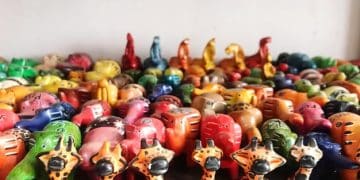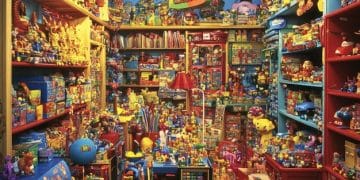The Rise of Sensory Toys: Autism Support in the US
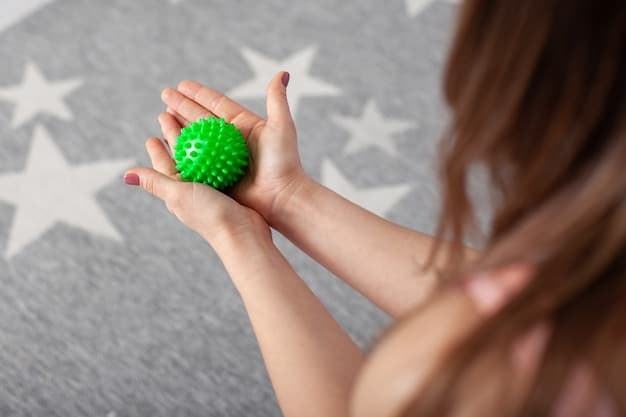
Sensory toys have emerged as vital tools in the US for supporting children with autism by providing therapeutic benefits, promoting sensory regulation, and aiding in the development of crucial life skills.
The world of toys is constantly evolving, but one area that has seen significant growth in recent years is the development and use of sensory toys for children with autism in the US. These toys are designed to engage specific senses and provide therapeutic benefits that help children with autism develop crucial life skills.
Understanding Sensory Toys and Autism
Sensory toys are specifically designed to stimulate one or more of the senses: sight, sound, touch, smell, and taste. For children with autism, these toys can be particularly beneficial in managing sensory processing challenges, which are often a core part of their experience.
Autism Spectrum Disorder (ASD) is a neurodevelopmental condition that affects how individuals interact with others, communicate, learn, and behave. Sensory sensitivities are common among individuals with autism, leading to either over-responsiveness (hypersensitivity) or under-responsiveness (hyposensitivity) to sensory stimuli. Sensory toys are often used in occupational therapy and at home to help manage these sensitivities.
The Role of Sensory Toys in Therapy
Sensory toys play a pivotal role in therapeutic settings by providing controlled sensory input that can help regulate a child’s sensory system. These toys are often integrated into occupational therapy sessions to help children develop coping mechanisms and adaptive behaviors.
By using sensory toys in a structured environment, therapists can help children learn to tolerate and even enjoy different sensory experiences. This can translate to improved focus, reduced anxiety, and better social interactions outside of therapy.
- ✅ Improving focus and attention span.
- ✅ Reducing anxiety and promoting relaxation.
- ✅ Developing fine motor skills through tactile exploration.
- ✅ Encouraging social interaction and communication.
In conclusion, understanding the link between sensory processing and autism is crucial. Sensory toys offer a practical and engaging way to support children with autism, helping them navigate sensory experiences more comfortably and confidently.
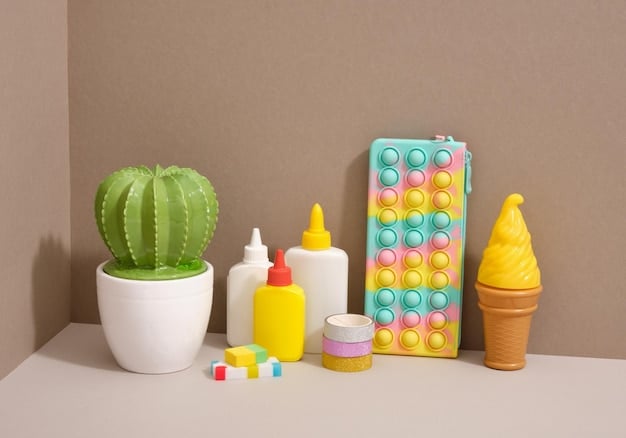
Benefits of Sensory Toys for Children with Autism
The benefits of sensory toys for children with autism extend beyond mere entertainment. These toys offer a range of developmental advantages that can significantly improve a child’s quality of life.
Sensory toys can help children with autism develop important skills such as fine motor skills, hand-eye coordination, and problem-solving abilities. The tactile experiences provided by these toys can be particularly beneficial for children who have motor skill challenges.
Emotional Regulation and Stress Reduction
Many sensory toys are designed to provide a calming effect, helping children regulate their emotions and reduce stress. Fidget toys, for example, can give children a constructive outlet for nervous energy.
The repetitive movements and tactile feedback from sensory toys can trigger the release of endorphins, which have a natural calming effect. This makes these toys a valuable tool for managing anxiety and preventing meltdowns.
- ✅ Providing a calming effect during stressful situations.
- ✅ Helping to reduce anxiety and emotional outbursts.
- ✅ Encouraging self-soothing behaviors.
- ✅ Promoting a sense of security and predictability.
In short, sensory toys offer numerous benefits for children with autism, from improving motor skills to promoting emotional regulation. These tools support overall development and enhance the quality of life for children on the autism spectrum.
Types of Sensory Toys Popular in the US
The market for sensory toys in the US is diverse, offering a wide range of options to cater to the unique needs of children with autism. Here are some of the popular types of sensory toys:
Tactile toys, visual toys, auditory toys, and proprioceptive toys are among the most popular types available. Each category stimulates different senses and offers unique therapeutic benefits.
Tactile Toys
Tactile toys are designed to engage the sense of touch and provide stimulating sensory input. These toys often feature different textures, shapes, and materials to encourage tactile exploration. Examples include textured balls, playdough, and sensory bins filled with rice or beans.
Many children with autism find comfort and enjoyment in tactile experiences. These toys help them to better understand and interact with their environment through touch.
Visual Toys
Visual toys capture attention and stimulate visual processing skills. These toys often involve bright colors, moving parts, and light effects. Examples include lava lamps, bubble tubes, and light-up toys.
- ✅ Lava lamps: Provide a soothing visual experience.
- ✅ Bubble tubes: Offer engaging movement and color changes.
- ✅ Light-up toys: Capture attention and stimulate visual tracking.
To summarize, the wide range of sensory toys available in the US ensures that parents and therapists can find the perfect options to meet the individual needs of children with autism. The goal is to provide positive sensory experiences that support growth, development, and well-being.
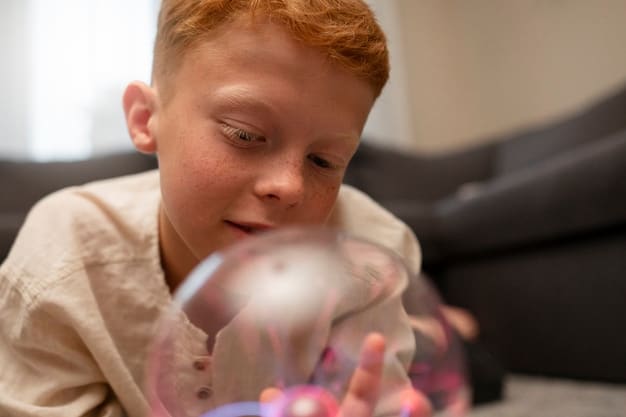
How to Choose the Right Sensory Toys
Selecting the right sensory toys for a child with autism involves careful consideration of their individual needs, sensitivities, and preferences. A toy that is beneficial for one child may not be suitable for another.
Consideration should be given to a child’s sensory preferences, safety, and durability. It’s also important to consider the child’s developmental level and any specific therapeutic goals.
Assessing Sensory Preferences
Understanding a child’s sensory preferences is key to choosing the right toys. Does the child prefer soft or rough textures? Are they drawn to bright colors or subdued hues? Observing their reactions to different sensory stimuli can provide valuable insights.
Some children are hypersensitive to certain stimuli, while others are hyposensitive. For example, a child who is hypersensitive to loud noises may prefer quiet toys, while a child who is hyposensitive to touch may benefit from toys with strong tactile feedback.
- ✅ Observe the child’s reactions to different sensory experiences.
- ✅ Consult with therapists or educators for insights.
- ✅ Introduce new toys gradually.
- ✅ Allow the child to lead the play.
In conclusion, choosing the right sensory toys requires careful consideration of a child’s individual needs, preferences, and sensitivities. By taking the time to assess these factors, parents and caregivers can select toys that provide therapeutic benefits and enhance the child’s overall well-being.
The Growing Market for Sensory Toys in the US
The market for sensory toys in the US has experienced substantial growth in recent years, driven by increased awareness of autism and the therapeutic benefits of sensory play. This growth has led to greater availability of sensory toys and a broader range of options for families and therapists.
Factors driving the growth of the sensory toy market include greater acceptance and understanding of autism, innovations in toy design, and increased availability through online retailers and specialty stores.
Impact of Online Retailers
Online retailers have played a significant role in the growth of the sensory toy market by providing easy access to a wide range of products. Parents and therapists can browse and purchase sensory toys from the comfort of their homes, with detailed descriptions and customer reviews to guide their decisions.
Online platforms also allow smaller and specialized toy manufacturers to reach a broader audience. This has led to greater innovation in the industry, with new and unique sensory toys being introduced regularly.
- ✅ Increased convenience and accessibility for consumers.
- ✅ Broader range of product options.
- ✅ Greater opportunities for small and specialized manufacturers.
- ✅ Enhanced product information through detailed descriptions and reviews.
To summarize, the future of the sensory toy market in the US looks promising, with continued growth expected as awareness of autism and the benefits of sensory play increase. This growth will likely lead to further innovations in toy design and greater availability of resources for families and therapists supporting children with autism.
Future Trends in Sensory Toys
As technology continues to advance, the future of sensory toys holds exciting possibilities. Innovations in design, materials, and technology are expected to shape the next generation of sensory tools for children with autism.
Future trends may include integration of virtual reality, personalized sensory experiences, and eco-friendly, sustainable materials in toy design. These trends aim to provide more engaging, effective, and responsible sensory solutions.
Integration of Virtual Reality
Virtual reality (VR) technology offers the potential to create immersive and controlled sensory environments. VR sensory toys could allow children with autism to experience different sensory stimuli in a safe and predictable setting.
VR simulations can be tailored to meet the specific needs and preferences of each child, providing a personalized sensory experience. For example, a child who is anxious about loud noises could use VR to gradually acclimate to these sounds in a controlled environment.
- ✅ Creating immersive and controlled sensory environments.
- ✅ Personalizing sensory experiences to meet individual needs.
- ✅ Providing safe and predictable sensory stimulation.
In conclusion, future trends in sensory toys point toward more personalized, technology-driven, and eco-conscious solutions. These trends offer exciting possibilities for enhancing the therapeutic benefits of sensory play and improving the lives of children with autism.
| Key Point | Brief Description |
|---|---|
| 🧩 Sensory Toys | Tools for sensory regulation and skill development. |
| 📈 Market Growth | Driven by autism awareness and online accessibility. |
| 💡 Future Trends | VR integration and personalized experiences. |
Frequently Asked Questions
▼
Sensory toys are designed to stimulate one or more of the senses, such as sight, sound, touch, smell, and taste. They’re often used to help children with autism manage sensory processing challenges.
▼
These toys can help improve focus, reduce anxiety, develop fine motor skills, and encourage social interaction. They provide a controlled and engaging sensory experience that promotes overall development.
▼
Popular types include tactile toys (textured balls, playdough), visual toys (lava lamps, bubble tubes), and auditory toys (musical instruments, sound machines). Each type stimulates different senses.
▼
Consider your child’s sensory preferences, sensitivities, and developmental level. Observe their reactions to different stimuli and consult with therapists or educators for insights.
▼
Future trends include the integration of virtual reality for immersive sensory experiences, personalized sensory solutions tailored to individual needs, and eco-friendly materials in toy design.
Conclusion
In conclusion, the rise of sensory toys for children with autism in the US reflects a growing understanding of sensory processing challenges and the importance of providing targeted support. These toys offer numerous benefits, from improving motor skills and emotional regulation to providing engaging and therapeutic sensory experiences. As the market continues to evolve, innovations in design and technology promise even more personalized and effective solutions for children with autism, enhancing their overall development and quality of life.



